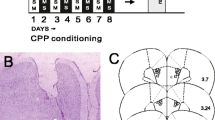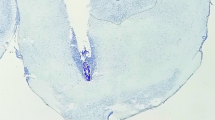Abstract
Rationale and objectives: The role of glutamatergic afferents from the hippocampus in the modulation of dopamine (DA) efflux in the nucleus accumbens (NAcc) and concomitant increases in locomotor activity was examined following brief high-frequency electrical stimulation of the ventral subiculum (vSub). Reverse dialysis of ionotropic glutamate receptor (iGluR) antagonists into the NAcc identified the relative contributions of N-methyl-d-aspartate (NMDA) and non-NMDA glutamate receptors in the modulation of DA efflux, whereas microinjection of these compounds or selective DA D1 or D2 receptor antagonists were used to analyze the roles of glutamatergic and DA receptors in the stimulation-induced hyperlocomotion. Methods and results: Electrical stimulation of the vSub at 20 Hz (10 s, 300 µA) induced a significant increase in (1) DA levels in the NAcc (≈30% from pre-stimulation DA levels) and (2) locomotor activity (≈400%). The evoked DA release was completely blocked by reverse dialysis of a selective non-NMDA antagonist DNQX (10 µM and 100 µM), whereas only a high dose of the NMDA antagonist AP-V (100 µM) was effective. The increased motor activity, however, was only slightly attenuated by reverse dialysis of these drugs. Bilateral intra-NAcc injection of DNQX (1 µg/0.5 µl) blocked the increased motor activity induced by vSub stimulation relative to saline treatment. In contrast, bilateral intra-NAcc injection of AP-V (1 µg/ 0.5 µl) alone caused a significant increase in locomotor activity. The increased motor activity induced by vSub stimulation appears to be mediated through the DA D1 receptor, as systemic administration of the D1 antagonist SCH 23390 (0.25 mg/kg and 1 mg/kg), but not the D2 antagonist sulpiride (2 mg/kg and 10 mg/kg) blocked these effects. Conclusions: These data indicate an important role for hippocampal glutamatergic afferents in modulating the release of DA through iGluR on DA-receptive neurons in the NAcc and possibly on output neurons to the ventral tegmental area, which subsequently elicits a prolonged increase in locomotor behavior. The role of this circuit in mediating context-dependent behavioral sensitization to repeated administration of psychostimulants is discussed.
Similar content being viewed by others
Author information
Authors and Affiliations
Additional information
Received: 13 October 1999 / Accepted: 21 December 1999
Rights and permissions
About this article
Cite this article
Taepavarapruk, P., Floresco, S. & Phillips, A. Hyperlocomotion and increased dopamine efflux in the rat nucleus accumbens evoked by electrical stimulation of the ventral subiculum: role of ionotropic glutamate and dopamine D1 receptors. Psychopharmacology 151, 242–251 (2000). https://doi.org/10.1007/s002130000376
Issue Date:
DOI: https://doi.org/10.1007/s002130000376




